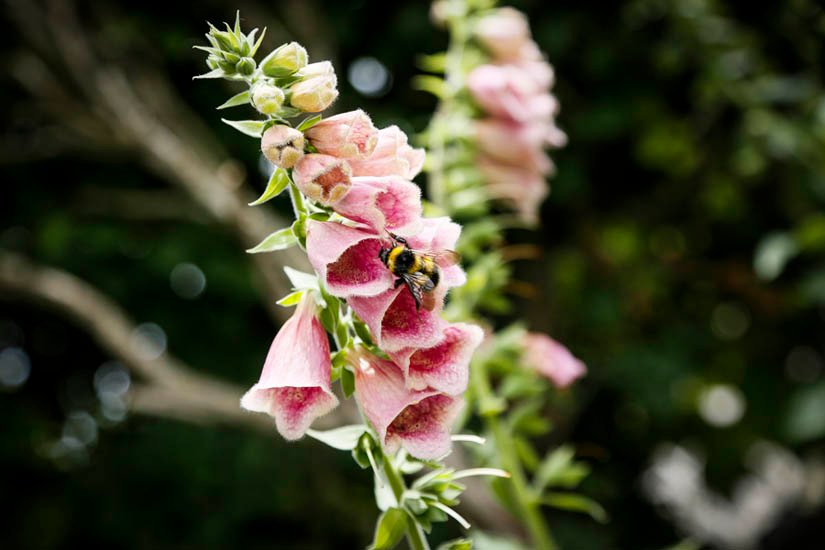
One of the many joys of having a well-planned garden is that you can have ready access to freshly-cut flowers to add colour and scent to your home all year round. Your home-grown flowers will be less expensive than the florist/shop bought variety and also there’s the extra satisfaction and enjoyment from growing your own cut flowers in a sustainable manner that then decorate your home both inside and out.

Eryngium
Getting Started
If you have the space, we recommend that you allocate a specific part of the garden purely for growing your cut flowers. Ideally, choose a sheltered, sunny spot; perhaps a dis-used vegetable plot or allotment, or an area of your garden that is out of view. This avoids raiding your existing borders and potentially compromising an attractive display in these areas. By planting in organised rows, in the same way you would cultivate vegetables, you can develop stronger plants by thinning out seedlings and regular hoeing to keep weeds down. Canes and frames can also be used to support taller plants without worrying that they will spoil the look of a favourite border.
If you do want to utilise an existing border then include shrubs and grasses with colourful or structural foliage and plant large groups of bulbs, annuals and perennials so that when you do cut flowers you won’t adversely affect the appeal of the bed.
Preparation and on-going care
Soil structure is key so if you have clay or sandy soils, you should start by applying organic matter to assist in drainage or moisture retention and then repeat this process annually. General fertilisers and regular mulching can help you generate taller plants with more abundant flowers. Depending on the weather and summer temperatures, regular weeding and watering will also be required.

Cotinus Grace (left) and Hydrangea (right)
Plant Selection
For annuals, such as scented Stocks and Sweet Peas it is more cost effective to buy seeds and, whilst they still have to be sown each year, you can also enjoy adding new or different varieties each year. Keep track of your success stories from previous years so you can mix and match some reliable favourites with some new exciting challenges. For a longer flowering season, sow these seeds in autumn or propagate them in your greenhouse.
Hardy annuals can be propagated by direct sowing in rows outside whereas half-hardy annuals prefer to be propagated indoors.
To prolong the season, choose herbaceous perennials and foliage plants that you can plant early, as many later varieties are unlikely to flower in their first year. For example, Delphinium and Echinacea, if planted early enough, will often flower in their first season.

Digitalis Purpurea
For late winter and early spring flowering, bulbs are the answer. Additionally, you can trick many bulbs by starting them off in cool and dark conditions before the bringing them indoors to flower from mid-winter onwards. Aim for a combination or early, mid and late flowering cultivars to extend the season and be prepared to discard and replace some bulbs that may not flower well in following years.
Evergreens and early-flowering shrubs offer invaluable cutting material during winter but otherwise provide decorative foliage throughout the year. However, before cutting, do ensure they are properly established and have begun flowering.
Finally don’t forget the climbers with flowers or attractive seed heads. And , of course, the amazing variety of roses now available make a beautiful addition to any display.
While there are hundreds of options to try, we have compiled a short list of some of our favourites but also some of the most successful varieties for our local Oxfordshire soils and climate.
George Recommends:
PERENNIALS FOR COLOUR
Alchemilla
Eryngium Electric Haze / Alpinum Superbum
Geum Princess Juliana
Delphinium Pacific Giants and Black Night
Digitalis Purpurea
Dahlia Bishop of Llandaff
Lavender Hidcote
Penstemon Barbatus Elfin Pink
Aster King George
Echinacea
Rudbeckia Goldstrum
Heuchera Obsidian
Peony Duchesse De Nemours
Zantedeschia Aethiopica Kiwi Blush
Iris Sibirica Dreaming Spires
FOLIAGE AND STRUCTURE
Cotinus Grace
Gypsophila Paniculata
Crambe Cordifolia
Verbena bonariensis
Hydrangeas
ROSES – PICK A COLOUR
Pink – Gertrude Jekyll
Yellow – Graham Thomas
White – Winchester Cathedral
Red – Charles De Mills

Zantedeschia (left) and Verbena Bonariensis (right)
By planning your garden with a cut flower area, you’ll have beautiful flowers both indoors and outside all year round!
For any advice on growing cut flowers or if we can help you with your next garden design project, please feel free to contact Jo or George on 01491 280447 or email info@greenart.co.uk.




